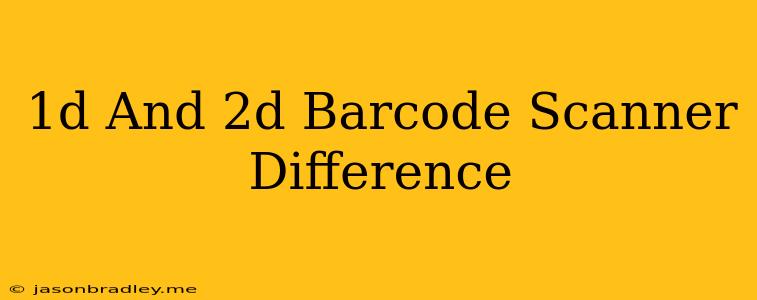1D vs 2D Barcode Scanners: What's the Difference?
Barcode scanners have become an essential part of modern retail, inventory management, and data processing. But with the evolution of technology, we have seen the emergence of different types of barcode scanners, with 1D and 2D scanners being the most common.
While both types of scanners read barcodes to capture data, they differ significantly in their functionality, capabilities, and applications. Here's a breakdown of the key differences between 1D and 2D barcode scanners:
1D Barcode Scanners
What is a 1D barcode scanner?
A 1D barcode scanner reads linear barcodes, which consist of a series of vertical lines of varying widths. These scanners are commonly used in retail settings to scan products with UPC or EAN barcodes.
Capabilities:
- Read linear barcodes (UPC, EAN, Code 39, etc.)
- Scan one barcode at a time
- Primarily used for inventory management and point-of-sale transactions
Advantages:
- Cost-effective: 1D scanners are typically less expensive than 2D scanners.
- Simple to use: They are easy to operate and require minimal training.
- Widely compatible: 1D scanners are compatible with a wide range of systems.
Disadvantages:
- Limited data capacity: 1D barcodes can store a limited amount of information.
- Less versatile: They can only read linear barcodes and are not capable of reading 2D barcodes.
2D Barcode Scanners
What is a 2D barcode scanner?
A 2D barcode scanner reads two-dimensional barcodes, such as QR codes, Data Matrix codes, and PDF417 codes. These barcodes contain a larger amount of data and can be scanned at any angle.
Capabilities:
- Read both linear and 2D barcodes
- Store large amounts of data
- Offer advanced features like image capture and digital signature capabilities
Advantages:
- High data capacity: 2D barcodes can store significantly more information than 1D barcodes.
- Versatility: They can read all types of barcodes, including 1D barcodes.
- Improved efficiency: They can scan barcodes at any angle and can even read damaged or partially obscured codes.
Disadvantages:
- Higher cost: 2D scanners are typically more expensive than 1D scanners.
- Complex setup: Some 2D scanners might require more advanced configuration.
When to Use Each Type
1D barcode scanners are suitable for:
- Retail stores
- Warehouses
- Inventory management
- Point-of-sale transactions
2D barcode scanners are ideal for:
- Healthcare applications (patient records, medication tracking)
- Manufacturing and logistics (tracking parts and inventory)
- Document management (e.g., storing documents in a digital format)
- Marketing and promotions (e.g., scanning QR codes for coupons or special offers)
Conclusion
The choice between a 1D and 2D barcode scanner depends on your specific needs and applications. While 1D scanners are cost-effective and simple to use, 2D scanners offer greater data capacity, versatility, and advanced features. By carefully considering your requirements, you can select the best barcode scanner for your business.
